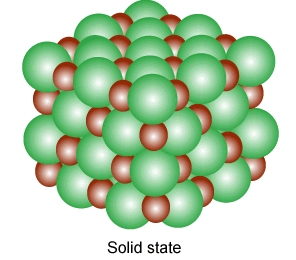In a solid AB, A atoms are in ccp arrangement and B atoms occupy all the octahedral sites. If two atoms from the opposite faces are removed, then the resultant stoichiometry of the compound is AxBy. The value of x is _____. [nearest integer]
Correct Answer: 3
Solution and Explanation
The correct answer is 3
A atoms are in CCP contribution of A is
A = 4
If atoms from opposite faces are removed then
\(A = 4− x × \frac{1}{x}\)
A = 3
Therefore , x = 3
Top Questions on The solid state
- A metal crystallizes in simple cubic lattice. The volume of one unit cell is \( 6.4 \times 10^{-7} \, \text{pm}^3 \). What is the radius of the metal atom in pm?
- AP EAPCET - 2025
- Chemistry
- The solid state
- A metal crystallises in two cubic phases, fcc and bcc with edge lengths 3.5 Å and 3 Å respectively. The ratio of densities of fcc and bcc is approximately
- TS EAMCET - 2025
- Chemistry
- The solid state
- How many kinds of Bravais lattice are possible in a crystal?
- Bihar Board XII - 2025
- Chemistry
- The solid state
- The percentage of free space in a body-centred cubic unit cell is
- Bihar Board XII - 2025
- Chemistry
- The solid state
- Which of the following is not a crystalline solid?
- Bihar Board XII - 2025
- Chemistry
- The solid state
Questions Asked in JEE Main exam
Match List-I with List-II.

Choose the correct answer from the options given below :- JEE Main - 2025
- Dimensional Analysis
- Which one of the following is the correct dimensional formula for the capacitance in F? M, L, T, and C stand for unit of mass, length, time, and charge.
- JEE Main - 2025
- Dimensional analysis
- The dimensions of a physical quantity \( \epsilon_0 \frac{d\Phi_E}{dt} \) are similar to:
- JEE Main - 2025
- Dimensional analysis
- What is the dimensional formula of \( \frac{1}{\mu_0 \epsilon_0} \) (where \( \mu_0 \) is permeability and \( \epsilon_0 \) is permittivity of free space)?
- JEE Main - 2025
- Dimensional analysis
The expression given below shows the variation of velocity \( v \) with time \( t \): \[ v = \frac{At^2 + Bt}{C + t} \] The dimension of \( A \), \( B \), and \( C \) is:
- JEE Main - 2025
- Dimensional Analysis
Concepts Used:
Solid State
Solids are substances that are featured by a definite shape, volume, and high density. In the solid-state, the composed particles are arranged in several manners. Solid-state, in simple terms, means "no moving parts." Thus solid-state electronic devices are the ones inclusive of solid components that don’t change their position. Solid is a state of matter where the composed particles are arranged close to each other. The composed particles can be either atoms, molecules, or ions.

Types of Solids:
Based on the nature of the order that is present in the arrangement of their constituent particles solids can be divided into two types;
- Amorphous solids behave the same as super cool liquids due to the arrangement of constituent particles in short-range order. They are isotropic and have a broad melting point (range is about greater than 5°C).
- Crystalline solids have a fixed shape and the constituent particles are arranged in a long-range order.